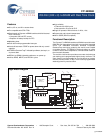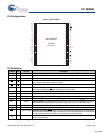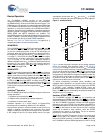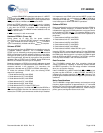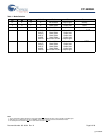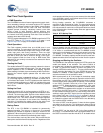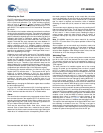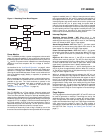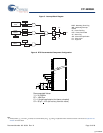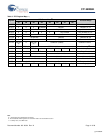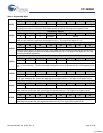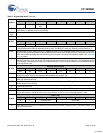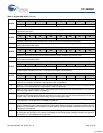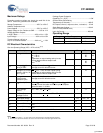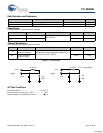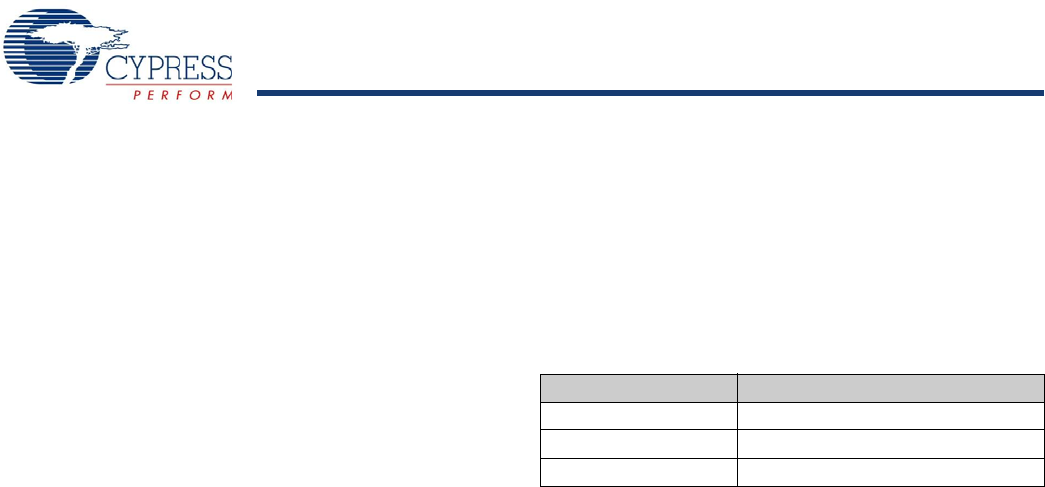
CY14B256K
Document Number: 001-06431 Rev. *H Page 7 of 28
Real Time Clock Operation
nvTIME Operation
The CY14B256K consists of internal registers that contain clock,
alarm, watchdog, interrupt, and control functions. RTC registers
use the last 16 address locations of the SRAM. Internal double
buffering of the clock and the clock and timer information
registers prevent accessing transitional internal clock data
during a read or write operation. Double buffering also
circumvents disrupting normal timing counts or clock accuracy of
the internal clock while accessing clock data. Clock and Alarm
registers store data in BCD format.
The RTC register addresses for CY14B256K range from 0x7FF0
to 0x7FFF. Refer to RTC Register Map[5, 6] on page 11 and
Register Map Detail on page 12 for detailed description.
Clock Operations
The Clock registers maintain time up to 9,999 years in one
second increments. The user sets the time to any calendar time
and the clock automatically keeps track of days of the week,
month, leap years, and century transitions. There are eight
registers dedicated to the clock functions that are used to set
time with a write cycle and to read time during a read cycle.
These registers contain the time of day in BCD format. Bits
defined as ‘0’ are currently not used and are reserved for future
use by Cypress.
Reading the Clock
The double buffered RTC register structure reduces the chance
of reading incorrect data from the clock. The user should stop
internal updates to the CY14B256K time keeping registers
before reading clock data, to prevent reading of data in transition.
Stopping the internal register updates does not affect clock
accuracy.
The updating process is stopped by writing a ‘1’ to the read bit
‘R’ (in the flags register at 0x7FF0), and does not restart until a
‘0’ is written to the read bit. The RTC registers are then read while
the internal clock continues to run. After a ‘0’ is written to the read
bit (‘R’), all CY14B256K registers are simultaneously updated
within 20 ms.
Setting the Clock
Setting the write bit ‘W’ (in the flags register at 0x7FF0) to a ‘1’
stops updates to the time keeping registers and enables the time
to be set. The correct day, date, and time is then written into the
registers in 24 hour BCD format. The time written is referred to
as the “Base Time”. This value is stored in nonvolatile registers
and used in the calculation of the current time. Resetting the
write bit to ‘0’ transfers the register values to the actual clock
counters, after which the clock resumes normal operation.
Backup Power
The RTC in the CY14B256K is intended for permanently
powered operation. The V
RTCcap
or V
RTCbat
pin is connected
depending on whether a capacitor or battery is chosen for the
application. When the primary power, V
CC
, fails and drops below
V
SWITCH
the device switches to the backup power supply.
The clock oscillator uses very little current, which maximizes the
backup time available from the backup source. Regardless of the
clock operation with the primary source removed, the data stored
in the nvSRAM is secure, having been stored in the nonvolatile
elements when power was lost.
During backup operation, the CY14B256K consumes a
maximum of 300 nanoamps at 2 volts. The user should choose
capacitor or battery values according to the application. Backup
time values based on maximum current specifications are shown
in the following table. Nominal backup times are approximately
three times longer.
Using a capacitor has the advantage of recharging the backup
source each time the system is powered up. If a battery is used,
a 3V lithium is recommended and the CY14B256K sources
current only from the battery when the primary power is removed.
The battery is not, however, recharged at any time by the
CY14B256K. The battery capacity must be chosen for total antic-
ipated cumulative down time required over the life of the system.
Stopping and Starting the Oscillator
The OSCEN bit in the calibration register at 0x7FF8 controls the
enable and disable of the oscillator. This active LOW bit is
nonvolatile and is shipped to customers in the “enabled” (set to
0) state. To preserve the battery life when the system is in
storage, OSCEN bit must be set to ‘1’. This turns off the oscillator
circuit, extending the battery life. If the OSCEN bit goes from
disabled to enabled, it takes approximately 5 seconds (10
seconds maximum) for the oscillator to start.
While system power is off, if the voltage on the backup supply
(V
RTCcap
or V
RTCbat
) falls below their respective minimum level,
the oscillator may fail.The CY14B256K has the ability to detect
oscillator failure when system power is restored. This is recorded
in the OSCF (Oscillator Failed bit) of the Flags register at
address 0x7FF0. When the device is powered on (V
CC
goes
above V
SWITCH
), the OSCEN bit is checked for “enabled” status.
If the OSCEN bit is enabled and the oscillator is not active within
the first 5 ms, the OSCF bit is set to “1”. The system must check
for this condition and then write ‘0’ to clear the flag. Note that in
addition to setting the OSCF flag bit, the time registers are reset
to the “Base Time” (see “Setting the Clock” on page 7), which is
the value last written to the time keeping registers. The Control
or Calibration registers and the OSCEN bit are not affected by
the “oscillator failed” condition.
The value of OSCF must be reset to ‘0’ when the time registers
are written for the first time. This initializes the state of this bit
which may have become set when the system was first powered
on.
To reset OSCF, set the write bit “W” (in the flags register at
0x7FF0) to “1” to enable writes to the Flag register. Write a “0” to
the OSCF bit and then reset the write bit to “0” to disable writes.
Table 2. RTC Backup Time
Capacitor Value Backup Time
0.1F 72 hours
0.47F 14 days
1.0F 30 days
[+] Feedback



